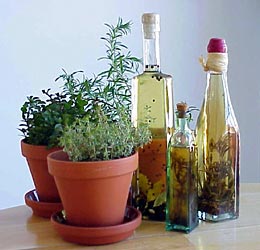How to Grow Herbs Indoors

Mediterranean region, most flavorful herbs don't thrive in the
un-Mediterranean environment and inadequate light our houses provide.
Herbs don't tolerate north-facing windows, or any window that gets less
than four hours of direct sunshine a day.
Provide Light
Acclimate Plants Gradually
Rosemary is a case in point. This slow-growing evergreen doesn't have the chance to adjust to changes in light before the plant slowly starves itself. By January, February, or March, the leaves dry up, and the plant dies. This sudden death is by far the most common complaint about growing rosemary indoors. Here's what to do: Gradually adjust the plant to lower light. Place it in partial shade for two to three weeks, then in deeper shade for another two to three weeks before bringing it indoors. When plenty of new growth appears, the plant is ready to go into the house.
Soil, Fertilizer, and Water
compost-based mix. Most herbs do well in soils of pH 6 to 7.
Many people incorrectly think that herbs grow better in poor soil. Flavors are stronger when culinary herbs grow outdoors in gardens. But in the confines of a pot, supplementary feedings with liquid fertilizer or organic fish emulsion are necessary. Feed herbs once a week when plants are actively growing, but not when dormant.
Watering is not a trivial matter with herbs. In general, water less often and more thoroughly, and only when the soil is actually dry. When the soil is dry to the touch, add water until it comes out the bottom of the pot. If the water doesn't come out, pots have a drainage problem. First, check that the holes aren't blocked; if not, you may have to repot with soil that has better drainage.
Pests and Diseases
Herbs are susceptible to common pests, including whiteflies, spider mites, aphids, mealybugs, scale insects, and thrips. Inspect herbs regularly.If your herbs are in portable containers, control pests by dipping the whole aboveground part of the plant into a pail of insecticidal soap. Swish vigorously for a minute or two to wet all leaf surfaces (hold your hand over the pot to prevent soil loss). Dipping once or twice a week for three to four weeks will clear up most problems.
Views: 16
Replies to This Discussion
-
In recent years, many new varieties of herbs have been introduced, some of which do better indoors than the traditional varieties. Here are 10 herbs notable for their consistent,
compact growth habit and strong flavor.
'Grolau' chives (Allium schoenoprasum): Strong flavor and thick, dark green leaves. Developed for forcing, 8 to 12 inches tall.
Seeds germinate in 10 to 14 days at 60° to 68° F.
'Fernleaf' dill (Anethum graveolens): Dwarf form of dill only 18 inches tall. Ideal for dill weed indoors. Standard
varieties grow too tall and bolt too soon. Easy from seeds, germinating
in 7 to 14 days at 60° to 68° F.
'English' mint (Mentha spicata): Perhaps the best-behaved spearmint variety (not as invasive as others, and the
leaves are broader and deeper green). Excellent for cooking and tea.
Easy to propagate from cuttings.
'Spicy Globe' basil (Ocimum basilicum minimum): Dense, compact form of basil, 8 to 10 inches tall. Good flavor. Grow from seed; germinates in 6 to 12 days at 68° to 77° F.
Greek oregano (Origanum vulgare hirtum): The true oregano for Mediterranean cooking, with excellent flavor and white
flowers. Watch out for the impostor (called wild marjoram) with pink
flowers and no flavor. Greek oregano grows well in pots, reaching 8 to
12 inches. Grows easily from seed in 7 to 21 days at 65° to 77° F.
Broadleaf thyme (Plectranthus amboinicus or Coleus amboinicus): Also known as Spanish thyme and Cuban oregano, this
plant has broad, fleshy leaves unlike those of ordinary thyme.
Wonderful, spicy thyme-oregano flavor and useful in many of the same
recipes as ordinary thyme. Never goes dormant. Grows from cuttings
only, and reaches 10 to 12 inches tall.
Vietnamese coriander (Polygonum odoratum): Not true coriander, but a good substitute. Regrows after cutting, unlike
true coriander, which must be reseeded after harvest. Grows 4 to 8
inches tall. Propagate from cuttings.
'Blue Boy' rosemary (Rosmarinus officinalis): More compact and diminutive than regular rosemary, reaching only 24
inches. Flowers freely and has excellent flavor. Propagated by cuttings
only.
Dwarf garden sage (Salvia officinalis 'Compacta'): Smaller leaves and more compact habit than regular sage,
growing only 10 inches high. Same sage flavor. Propagated by cuttings
only; seeds are unavailable.
Creeping savory (Satureja repandra or S. spicigera): Flavor identical to that of winter savory, but easier and faster to
grow indoors. Reaches only 2-4 inches in height, but fills the pot with
a dense mat of foliage. Difficult to find seeds, but grows readily from
cuttings. -
© 2025 Created by Aggie.
Powered by
![]()